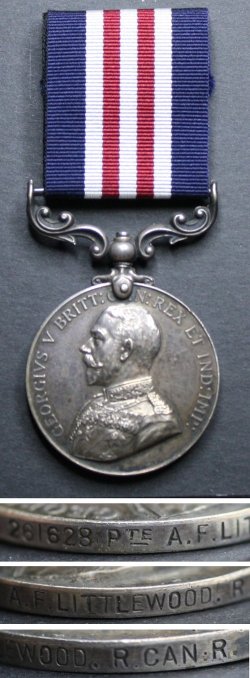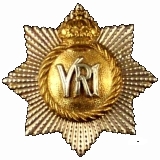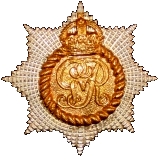
The First World War
Soldiers and Non-Commissioned Officers
of The Royal Canadian Regiment
261628 Private Arthur Frederick Littlewood
By: Captain Michael O'Leary, The RCR

Military Medal awarded to 261628 Private Arthur Frederick Littlewood, The R.C.R.
Arthur Frederick Littlewood was born on 10 Dec 1890 at Leicestershire, England. In 1916, he was employed as a farmhand when he attested for overseas service with the Canadian Expeditionary Force (CEF) on 8 July 1916 at Winnipeg, Manitoba. He was recorded as having an apparent age of 25 years, 6 months at attestation. Littlewood was 5 feet 2 inches in height and weighed 135 lbs. His physical development was described as fair. He had a light complexion, grey eyes and brown hair. Littlewood's religion was recorded as Church of England.
A single man, Arthur Littlewood identified his sister as his next of kin when he joined the CEF. Elizabeth Littlewood lived at Lower Tooting, 16 Hanche Court Rd., London, England.
Littlewood originally attested for service with the 212th Overseas Battalion and transferred to the 97th Infantry Battalion when it absorbed the men of the 212th. The 97th Battalion was itself absorbed into the R.C.R. and P.P.C.L.I. Depot unit. He would later serve at the front with The RCR.
Private Arthur Littlewood embarked for England at Halifax, Nova Scotia aboard the troopship S.S. OLYMPIC on 18 September 1916. A week later, on the 25th, he disembarked in England with the 97th Battalion. After a month in England he was transferred from the 97th Canadian Infantry Battalion to The Royal Canadian Regiment (The RCR). The day after his transfer to The RCR, on the 22nd of October, he arrived in France on his way to the front lines. His journey forward took three days and on the 25th he arrived at the unit.
Littlewood served without incident until February of 1917 when he was sent to the Field Ambulance sick. He was diagnosed with Pyrexia of Unknown Origin (P.U.O) and spent a week at No. 30 Casualty Clearing Station before returning to his unit. Again in June of 1917, he spent a few days at No. 8 Canadian Field Ambulance under a similar diagnosis.
On 15 September 1917, while the Regiment was out of the lines at Le Pendu Camp, Arthur Littlewood was granted 10 days leave to Paris. He rejoined from leave on 26 September in the field at Neuville St. Vaast.
Littlewood served at the front for another year before his service record notes further incidents. From the 27th until the 30th of September, 1918, The RCR was in action at Cambrai and the regimental War Diary describes the period as "fair, some rain, conditions generally good."
Unlike much of the Regiment's war diary, with relatively short daily entries, the Cambrai fighting merited a detailed description in an attached annex:
Appendix 9 - RCR CEF War Diary, September 1918
NARRATIVE OF OPERATIONS, 28th., 29th., 30th., September, 1918.
Part I.
On the 26th September 1918, the Regiment moved from DAINVILLE Area by meter-bus to BULLECOURT; then marched to assembly area through QUEANT arriving there 5.20 morning of 27th September. At 8.30 a.m. they moved to E.5.d. with a strength of 23 Officers and 588 other ranks. At 6.00 p.m. they again moved to F.1.b. remaining until 3.00 a.m. 29th September, when they moved to BURION WOOD. "D", "C" and "A" Companies being in the front line, "B" Company in reserve.
At 5.30 a.m. they jumped off. Little opposition was met with during preliminary stages, the prisoners taken numbered about 50. One long field gun and one light field gun being captured. Opposition was met and heavy Machine Gun fire at F.4.d. on the right, and F.4.a. The right company was temporarily checked, but an opening being located in enemy wire, a footing was gained in MARCOING LINE. On the left the enemy still occupied houses along the CAMBRAI Road and RAILLENCOURT and sever fighting took place. Three anti-tank guns were encountered and put out of action on the CAMBRAI ROAD between RAILLENCOURT and part of SAILLY with the intention of coming behind the village of ST. OLLE, but were infeladed [sic] by Machine Gun Fire from high ground on the extreme right of the Brigade Frontage and houses in ST. OLLE.
The remaining two platoons of the Reserve Company were instructed and worked up the CAMBRAI ROAD from house to house towards ST. OLLE. Word was then received from Reserve Company that the right company that was clearing the MARCOING Trench, was being forced back owing to lack of grenades, and that the enemy were attempting to come from the MARCOING SUPPORT LINE to the MARCOING LINE. A platoon of the Reserve Company, picking stragglers from "A" and "C" Companies, was sent to MARCOING LINE to reinforce the right company. MARCOING LINE was then cleared of the enemy as far as F.5.c.7.0. This was at 12.30 p.m.
Touch with the left flank was established, the right flank being in the air.
Battalion Headquarters was established at F.4.d.40.30; R.A.P. at X.28.e.70.00.
The MARCOING SUPPORT LINE was also occupied, at 8.30 p.m. by two companies, the other two remaining in MARCOING LINE.
Part II.
On the night of 29th September, the battalion reorganized as three companies. They assembled at S.19.Central at 5.30 a.m. September 30th.
After jumping off, intense Machine Gun Fire was encountered from both flanks, especially from the left, as well as frontal from S.16.Central.
Left company reached the Chapel in S.15.b. Considerable casualties were caused. The position eventually became untenable and the 4TH Division were falling back on the left flank. Finally position was established in the sunken road running through S.20.b.
At noon, information was received that BLECOURT and TILLOY WOOD were occupied by our troops and we again jumped off, but as this information proved to be incorrect, Machine Guns opened fire from these places and stopped our advance. One Officer and 40 other ranks remained dug-in at S.21.a. Another attempt was again made at 4.00 p.m. on information received that the enemy were retiring from TILLOY WOOD, and that SANCOURT was occupied by our troops; this was also incorrect as the advance was checked by cross-fire from both flanks. At 6.00 p.m. the Battalion was holding positions as follows: In sunken road in S.20.b. and S.21.a. This line was held until the 9TH Brigade passed through at 5.00 a.m. 1st October.
REMARKS.
Not enough liaison between Infantry and Artillery, as was emphasized when advance was checked by Machine Guns in houses in ST. OLLE, on the 28th September and Artillery could not be notified of it.
On the 28th September, the tanks worked too far to the right, one tank which went to the right was put out of action by Machine Gun Fire. Remaining three on the left were put out of action by Machine Gun Fire and one Gun of fairly heavy calibre with open sights.
Bombs figured greatly in clearing the MARCOING LINE.
Estimated Machine Guns captured amounted to 54. Prisoners seen returning 130, captured guns and anti-tank guns 5. Casualties inflicted on the enemy were approximately 700.
LESSONS LEARNED.
1. No matter how far the advance, a Battalion Headquarters should be permanently established (series of report centres mapped out) and if it is to be moved someone should be left to re-direct messages to new Battalion Headquarters.
2. That a two company frontage on the same proportion as a Battalion frontage could be as effective, and save casualties if greater interval was maintained.
3. That the support (P.P.C.L.I.) Bn. were too close behind us (R.C.R.) and in one instance got between our Reserve Company and front Companies.
4. Whippets would have proved effective in the fighting where the Mark IV or V were useless.
3-10-1918.
(signed) C.L. Wood, Captain, Commanding The Royal Canadian Regiment.
On 27 September 1918, as Littlewood and The RCR were engaged in battle at Cambrai, his award of the Military Medal was published in the 3rd Canadian Division Order, number 3542. It was later gazetted on 11 February 1919.
Cambrai was to be Arthur Littlewood's last battle of the Great War. He was seriously wounded by shrapnel on 29 September 1918.
The Royal Canadian Regiment suffered heavy losses over those few days of fighting at Cambrai. Of 23 Officers and 588 other ranks, the casualties noted in the War Diary at the time were:
- Officers:-
- Killed in Action. - 3
- Died of Wounds. - 1
- Wounded. - 16
- Killed in Action. - 51
- Died of Wounds. - 1
- Wounded in action. - 185
- Missing. - 53
- Wounded at Duty. - 3
- Other ranks:-
[An interesting historical note - Major G.B. Topp of the 42nd Canadian Infantry Battalion was making a reconnaissance of the line on the early morning of the 28 September. As he arrived at the headquarters of The RCR, a shell struck the HQ dugout, seriously wounding the Commanding Officer and killing the Adjutant. As all twelve company officers in the lines were Lieutenants and already engaged in the operation at hand, Major Topp was ordered to take command of the Battalion and did so until early morning on the 29th when he rejoined his own Battalion to guide it forward. Maj Topp was wounded by 0830 hours on the 29th and was evacuated from the field. A letter he wrote in 1936 to the Historical Section of the Department of National Defence, which forms part of The RCR's war diary, notes that as he laid in his hospital bed some days later, he wrote the recommendation for the Victoria Cross awarded to Lieutenant Milton F. Gregg, the only member of the Regiment to be so honoured during the Great War.]
After being wounded on the 29th of September, Littlewood began the long slow road to recovery. After three days in the Casualty Clearing Station, he started his hospital care with a stay of 23 days at No. 26 General Hospital, Etaples, on 4 October. From there he traversed a number of hospital as he moved rearward and eventually towards repatriation to Canada: 3rd West General, Manchester (98 days from 25 Oct 1918); Military Convalescent Hospital, Epsom (5 days from 30 Jan 1919); Granville Convalescent Special Hospital, Buxton (from 5 Feb 1919); and thence to No. 5 Canadian General, Kirkdale (from 25 Apr 1919). Littlewood was finally invalided to Canada on 23 May 1919.
The severity of Littlewood's injuries are poorly captured by the cryptic notation of the Casualty Clearing Station's diagnosis: "S.W. both arms and face and left leg."
On admission to the Granville Canadian Special Hospital, his wounds at that time were described in more detail as follows:
6 Feb 1919 - S.W. Left and Right Arm and Left Knee.
Lt Arm - Arm practically blown off. Amputated at C.C.S. No other operations, no sutures. has closed in, no discharge.
Rt Arm - Penetrating wound at elbow joint fracturing bones. F.B. removed and wound excised. Wound has healed, no other operations.
Left Knee - Penetrating wound left knee inner side patella - Fracturing bones. F.B. removed and joint cleaned up. Sepsis. Sutures removed in France and wound cleansed. Not sutured. Wound has been healed about 6 weeks now.
Present Condition:
Left arm amputated 4 inches below tip of acromion - circular - healed. Scar adherent to stump of humerus which is very superficial. Complains of considerable pain in stump. Some pain referred to hand. Movement of shoulder joint slightly restricted.
Right arm - Healed depressed adherent scar outer side right elbow. Absolutely no movement at elbow, joint ankylosed at angle of 90 degrees and forearm in mid position between supination and pronation. Wrist movement normal. Complains of considerable pain in elbow joint. Grip of hand about 1/5 normal.
Left Knee - Deeply depressed adherent scar inner side of patella. Limitation of knee movement R.G.E 80 degrees A.G.F. 175 degrees. Considerable wasting of Quadriceps muscle.
Littlewood's injuries left him with one arm amputated well above the elbow, and the other ankylosed, with limited movement of his left knee and a variety of other scars.
On 2 June 1919, he finally arrived back in Canada aboard the S.S. MEGANTIC. He disembarked at Quebec City and remained in the care of the hospital system for a few months longer. Arthur Littlewood was discharged from the CEF on 13 August 1919 at No. 2 District Depot, Toronto, Ontario. He declared his proposed residence after discharge as 4 Sondes St., Walworth, London, England.
On 30 July 1919, Arthur Littlewood confirmed that he had received an artificial arm from the Department of Soldiers' Civil Re- Establishment at the Dominion Orthopedic Hospital in Toronto, Ontario. The noted artificial arm was described as being of the Dress pattern and was declared by him to be "satisfactory to me in every respect."
As a Private of the CEF, Littlewood was paid throughout the War $1.00 per day with an additional 10 cents daily Field Allowance. His calculated War Service Gratuity was $420 (Cdn) and it was issued in England (GBP 71/18/4).
After the war, Littlewood reported his addresses as 4 Sondes St., Walworth, London, England and later as 315 Albany Rd, P.O. Camberwall, London.
Arthur Frederick Littlewood died 20 Apr 1945.
Pro Patria
- The O'Leary Collection; Medals of The Royal Canadian Regiment.
- Researching Canadian Soldiers of the First World War
- Researching The Royal Canadian Regiment
- The RCR in the First World War
- Badges of The RCR
- The Senior Subaltern
- The Minute Book (blog)
- Rogue Papers
- Tactical Primers
- The Regimental Library
- Battle Honours
- Perpetuation of the CEF
- A Miscellany
- Quotes
- The Frontenac Times
- Site Map

![]() The RCR in the Great War
The RCR in the Great War
![]() War Diary
War Diary
![]() Battle Honours
Battle Honours
![]() Battle Bars and The RCR
Battle Bars and The RCR
![]() The RCR Battle Bar Ledger (pdf)
The RCR Battle Bar Ledger (pdf)
![]() Honours and Awards
Honours and Awards
![]() Roll of Honour
Roll of Honour
![]() Prisoners of War
Prisoners of War
![]() Cemetery List
Cemetery List
![]() Cemetery Map
Cemetery Map
![]() Courts Martial
Courts Martial
![]() Officers
Officers
![]() RSMs of The RCR (1914-1919)
RSMs of The RCR (1914-1919)
![]() NCOs and Soldiers
NCOs and Soldiers
![]() An Officer's Diary (1914-1918)
An Officer's Diary (1914-1918)
![]() Recollections of a Nonagenerian (R. England) (1916-1919)
Recollections of a Nonagenerian (R. England) (1916-1919)
![]() On to Bermuda (1914-15)
On to Bermuda (1914-15)
![]() England and France 1915-1916 (Hayes; 1931)
England and France 1915-1916 (Hayes; 1931)
![]() Overseas with The Royals (1915)
Overseas with The Royals (1915)
![]() Regimental History Pamphlet (1917)
Regimental History Pamphlet (1917)
![]() Amiens (1918)
Amiens (1918)
![]() Cambrai (1918)
Cambrai (1918)
![]() Monchy-le-Preux (1918)
Monchy-le-Preux (1918)
![]() Under-aged Soldiers in The RCR
Under-aged Soldiers in The RCR
![]() Not All Were Volunteers; The RCR and the Military Service Act
Not All Were Volunteers; The RCR and the Military Service Act
![]() Sentenced to Death by Court Martial
Sentenced to Death by Court Martial
![]() The 7th Trench Mortar Battery
The 7th Trench Mortar Battery
![]() A Regimental Goat
A Regimental Goat
![]() Regiment and Family, Bermuda 1914-15
Regiment and Family, Bermuda 1914-15
![]() "March the Guilty Bastard In"
"March the Guilty Bastard In"
![]() Surrendered as Stowaway
Surrendered as Stowaway
![]() Re-Visiting the Great War Roll of Honour for The RCR
Re-Visiting the Great War Roll of Honour for The RCR
![]() Canadian Corps Trench Standing Orders (1916)
Canadian Corps Trench Standing Orders (1916)

